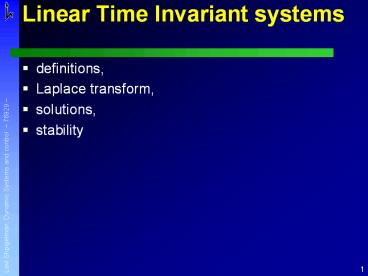Linear%20Time%20Invariant%20systems - PowerPoint PPT Presentation
Title:
Linear%20Time%20Invariant%20systems
Description:
Use linearity, and a some table entries to conclude: Sign{ } growth or decay ... Use table entries (as before) to conclude: Reformulate y(t) in terms of and. Where: ... – PowerPoint PPT presentation
Number of Views:204
Avg rating:3.0/5.0
Title: Linear%20Time%20Invariant%20systems
1
Linear Time Invariant systems
- definitions,
- Laplace transform,
- solutions,
- stability
2
Ready to GO !?
- Disclaimer the following slides are a quick
review of Linear, Time Invariant systems - If you feel a bit disoriented think
- I can easily read up on it (references will be
given) - Its VERY simple if youve seen it before (i.e.
intuitive). - This part will be over soon.
3
Lumpedness and causality
- Definition a system is lumped if it can be
described by a state vector of finite dimension.
Otherwise it is called distributed.Examples - distributed system y(t)u(t-? t)
- lumped system (mass and spring with friction)
- Definition a system is causal if its current
state is not a function of future events (all
real physical systems are causal)
4
Linearity and Impulse Response description of
linear systems
- Definition a function f(x) is linear if(this
is known as the superposition property) - Impulse response
- Suppose we have a SISO (Single Input Single
Output) system system as follows - where
- y(t) is the systems response (i.e. the observed
output) to the control signal, u(t) . - The system is linear in x(t) (the systems state)
and in u(t)
5
Linearity and Impulse Response description of
linear systems
- Define the systems impulse response, g(t,?), to
be the response, y(t) of the system at time t, to
a delta function control signal at time ? (i.e.
u(t)?t,t) given that the system state at time ?
is zero (i.e. x(?)0 ) - Then the system response to any u(t) can be found
by solving - Thus, the impulse response contains all the
information on the linear system
6
Time Invariance
- A system is said to be time invariant if its
response to an initial state x(t0) and a control
signal u is independent of the value of t0. - So g(t,?) can be simply described as g(t)g(t,0)
- A time linear time invariant system is said to be
causal if - A system is said to be relaxed at time 0 if x(0)
0 - A linear, causal, time invariant (SISO) system
that is relaxed at time 0 can be described by
7
LTI - State-Space Description
Fact (instead of using the impulse response
representation..)
- Every (lumped, noise free) linear, time invariant
(LTI) system can be described by a set of
equations of the form
8
What About nth Order Linear ODEs?
- Can be transformed into n 1st order ODEs
- Define new variable
- Then
Dx/dt A
x B
u y I 0 0 ? 0 x
9
Using Laplace Transform to Solve ODEs
- The Laplace transform is a very useful tool in
the solution of linear ODEs (i.e. LTI systems). - Definition the Laplace transform of f(t)
- It exists for any function that can be bounded by
ae?t (and sgta ) and it is unique - The inverse exists as well
- Laplace transform pairs are known for many useful
functions (in the form of tables and Matlab
functions) - Will be useful in solving differential equations!
10
Some Laplace Transform Properties
- Linearity (superposition)
- Differentiation
- Convolution
- Integration
11
Some specific Laplace Transforms (good to know)
- Constant (or unit step)
- Impulse
- Exponential
- Time scaling
12
Using Laplace Transform to Analyze a 2nd Order
system
- Consider the unforced (homogenous) 2nd order
system - To find y(t)
- Take the Laplace transform (to get an algebraic
equation in s) - Do some algebra
- Find y(t) by taking the inverse transform
13
2nd Order system - Inverse Laplace
- The solution of the inverse depends on the nature
of the roots ?1,?2 of the characteristic
polynomial p(s)as2bsc - real distinct, b2gt4ac
- real equal, b24ac
- complex conjugates b2lt4ac
- In shock absorber exampleam, bdamping coeff.,
cspring coeff. - We will see Re?? exponential effectIm??
Oscillatory effect
14
Real Distinct roots (b2gt4ac)
- Some algebra helps fit the polynomial to Laplace
tables. - Use linearity, and a table entry To conclude
- Sign? ? growth or decay
- ? ? rate of growth/decay
15
Real Equal roots (b24ac)
- Some algebra helps fit the polynomial to Laplace
tables. - Use linearity, and a some table entries to
conclude - Sign? ? growth or decay
- ? ? rate of growth/decay
16
Complex conjugate roots (b2lt4ac)
- Some algebra helps fit the polynomial to Laplace
tables. - Use table entries (as before) to conclude
- Reformulate y(t) in terms of ? and ?Where
17
Complex roots (b2lt4ac)
- For p(s)s20.35s1 and initial condition
y(0)1,y(0)0 - The roots are ??i?-0.175i0.9846
- The solution has formand the constants
areA?1.0157r0.5-i0.0889?arctan(Im(r)/Re(r
)) -0.17591 - We see the solution is an exponentially
decaying oscillation where the decay is
governed by ? and the oscillation by ?.
18
The Roots of a Response
19
(Optional) Reading List
- LTI systems
- Chen, 2.1-2.3
- Laplace
- http//www.cs.huji.ac.il/control/handouts/laplace
_Boyd.pdf - Also, Chen, 2.3
- 2nd order LTI system analysis
- http//www.cs.huji.ac.il/control/handouts/2nd_ord
er_Boyd.pdf - Linear algebra (matrix identities and eigenstuff)
- Chen, chp. 3
- Stengel, 2.1,2.2

